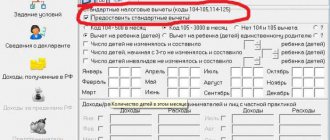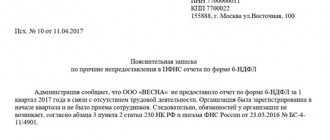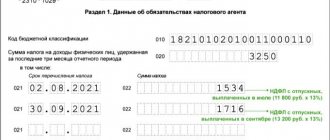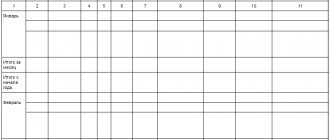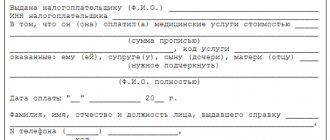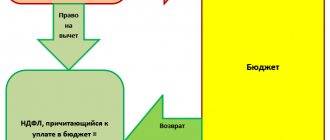Tax period code
In 3-NDFL, the tax period (code) is the period of time for which you are reporting. Each time period is indicated by a digital value, depending on the period for which the declaration is submitted and indicated on the title page.
| 21 | First quarter |
| 31 | Half year |
| 33 | Nine month |
| 34 | Year |
Tax period 34
Code 34 in most cases corresponds to a tax period equal to a calendar year. For example, this is the code that is entered in declarations for the simplified tax system, personal income tax and corporate property tax.
When filling out income tax reporting, you need to take into account the following nuance. In the annual return, code 34 is indicated by those taxpayers who submit returns quarterly. If the organization reports profit monthly, then the final declaration contains the number 46, which also indicates the year.
Taxpayer category code in the 3-NDFL declaration
On the title page of the form you will also find the payer category code for 3-NDFL. The categories are listed in Appendix No. 1 to the procedure for filling out reports. For ordinary citizens, the appropriate 3-NDFL taxpayer category code is “760,” and the 3-NDFL taxpayer category code “720” is allocated for individual entrepreneurs.
| 720 | An individual registered as an individual entrepreneur |
| 730 | Notary engaged in private practice and other persons engaged in private practice |
| 740 | Lawyer who established a law office |
| 750 | Arbitration manager |
| 760 | Another individual declaring income in accordance with Articles 227.1 and 228 of the Tax Code, as well as for the purpose of obtaining tax deductions in accordance with Articles 218-221 or for another purpose |
| 770 | Individual entrepreneur - head of a peasant (farm) enterprise |
Code of the country
In the “Country code” field, indicate the code of the state of which the person submitting the declaration is a citizen. Determine the code yourself using the All-Russian Classifier of Countries of the World (OKSM), approved by Gosstandart Decree of December 14, 2001 529-ST. For Russian citizens, enter the code “643”. If a person does not have citizenship, indicate the code of the country that issued him an identity document.
Taxpayer category code
In the “Taxpayer Category Code” field, enter the code in accordance with Appendix No. 1 to the Procedure approved by Order of the Federal Tax Service of Russia dated December 24, 2014 No. ММВ-7-11/671. For an individual entrepreneur, enter “720” in this field, for individuals – “760”. Separate codes are provided for notaries, lawyers and heads of peasant (farm) households.
FULL NAME. and personal data
Please indicate your last name, first name and patronymic in full, without abbreviations, as in your passport. Writing in Latin letters is allowed only for foreigners (subclause 6, clause 3.2 of the Procedure approved by order of the Federal Tax Service of Russia dated December 24, 2014 No. ММВ-7-11/671).
At the top of each page you fill out, indicate your Taxpayer Identification Number, as well as your last name and initials. The TIN must be filled out if the declaration is submitted by an entrepreneur. Individuals may not fill out this field, in which case they will have to provide passport data (clause 1.10 and subclause 7 of clause 3.2 of the Procedure approved by order of the Federal Tax Service of Russia dated December 24, 2014 No. ММВ-7-11/671).
Taxpayer status
In this field you must indicate whether the citizen is a resident or non-resident of the Russian Federation.
If a citizen has been in Russia for more than 183 calendar days over the past 12 months, then he is a resident. In this case, indicate the number 1. If less, enter the number 2. Read the article on how to find out whether an individual is a resident or a non-resident.
Residence
In the “Place of residence of the taxpayer” field, enter the number 1 if you have a residence permit in Russia. If there is no registration, but there is registration at the place of residence, indicate the number 2.
Indicate the postcode, district, city, town, street, house, building and apartment number based on the entry in your passport or certificate of registration of residence. If you do not have a place of residence, please indicate your registered address at your place of residence. Take it from your residence registration certificate.
In the "Region" field, enter the region code. It can be determined using Appendix 3 to the Procedure approved by Order of the Federal Tax Service of Russia dated December 24, 2014 No. ММВ-7-11/671.
Such rules are established by subclause 9 of clause 3.2 of the Procedure approved by order of the Federal Tax Service of Russia dated December 24, 2014 No. ММВ-7-11/671.
The field “Residence address outside the territory of the Russian Federation” is filled in only by non-residents.
Document type code in the 3-NDFL declaration
On the title page of the declaration, in the section about the identity document, indicate its code value. The full list is contained in Appendix No. 2 to the procedure for filling out 3-NDFL and in the following table.
| 21 | Russian citizen passport |
| 03 | Birth certificate |
| 07 | Military ID |
| 08 | Temporary certificate issued in lieu of a military ID |
| 10 | Foreign citizen's passport |
| 11 | Certificate of consideration of an application for recognition of a person as a refugee on the territory of Russia on the merits |
| 12 | Residence permit in the Russian Federation |
| 13 | Refugee ID |
| 14 | Temporary identity card of a Russian citizen |
| 15 | Temporary residence permit in the Russian Federation |
| 18 | Certificate of temporary asylum on the territory of the Russian Federation |
| 23 | Birth certificate issued in another state |
| 24 | Identity card of a Russian military personnel, military ID of a reserve officer |
| 91 | Other documents |
How to abbreviate “By whom the passport was issued” in a tax return
According to the instructions (clause 7.2.), personal data is recorded in accordance with how they are indicated in the identity document. There are two lines for the “issued by” field:
If the contents of the “by whom the passport was issued” field in 3-NDFL does not fit and does not fit completely into the cells, you can use two methods:
- Use abbreviations (the list of permitted ones is given in Order of the Ministry of Finance dated November 5, 2015 No. 171n), for example:
- Do not indicate passport data at all if the TIN number is registered. The rules allow taxpayers to do this - individuals. individuals, but not individual entrepreneurs.
Region code of the Russian Federation
In the “Address and telephone” section on the title page, you must indicate the code designation of the Russian region. Find the region (code) for 3-NDFL in Appendix No. 3 to the filling procedure, or in the following table:
| 01 | Republic of Adygea |
| 02 | Republic of Bashkortostan |
| 03 | The Republic of Buryatia |
| 04 | Altai Republic |
| 05 | The Republic of Dagestan |
| 06 | The Republic of Ingushetia |
| 07 | Kabardino-Balkarian Republic |
| 08 | Republic of Kalmykia |
| 09 | Karachay-Cherkess Republic |
| 10 | Republic of Karelia |
| 11 | Komi Republic |
| 12 | Mari El Republic |
| 13 | The Republic of Mordovia |
| 14 | The Republic of Sakha (Yakutia) |
| 15 | Republic of North Ossetia–Alania |
| 16 | Republic of Tatarstan (Tatarstan) |
| 17 | Tyva Republic |
| 18 | Udmurt republic |
| 19 | The Republic of Khakassia |
| 20 | Chechen Republic |
| 21 | Chuvash Republic – Chuvashia |
| 22 | Altai region |
| 23 | Krasnodar region |
| 24 | Krasnoyarsk region |
| 25 | Primorsky Krai |
| 26 | Stavropol region |
| 27 | Khabarovsk region |
| 28 | Amur region |
| 29 | Arhangelsk region |
| 30 | Astrakhan region |
| 31 | Belgorod region |
| 32 | Bryansk region |
| 33 | Vladimir region |
| 34 | Volgograd region |
| 35 | Vologda Region |
| 36 | Voronezh region |
| 37 | Ivanovo region |
| 38 | Irkutsk region |
| 39 | Kaliningrad region |
| 40 | Kaluga region |
| 41 | Kamchatka Krai |
| 42 | Kemerovo region |
| 43 | Kirov region |
| 44 | Kostroma region |
| 45 | Kurgan region |
| 46 | Kursk region |
| 47 | Leningrad region |
| 48 | Lipetsk region |
| 49 | Magadan Region |
| 50 | Moscow region |
| 51 | Murmansk region |
| 52 | Nizhny Novgorod Region |
| 53 | Novgorod region |
| 54 | Novosibirsk region |
| 55 | Omsk region |
| 56 | Orenburg region |
| 57 | Oryol Region |
| 58 | Penza region |
| 59 | Perm region |
| 60 | Pskov region |
| 61 | Rostov region |
| 62 | Ryazan Oblast |
| 63 | Samara Region |
| 64 | Saratov region |
| 65 | Sakhalin region |
| 66 | Sverdlovsk region |
| 67 | Smolensk region |
| 68 | Tambov Region |
| 69 | Tver region |
| 70 | Tomsk region |
| 71 | Tula region |
| 72 | Tyumen region |
| 73 | Ulyanovsk region |
| 74 | Chelyabinsk region |
| 75 | Transbaikal region |
| 76 | Yaroslavl region |
| 77 | Moscow |
| 78 | Saint Petersburg |
| 79 | Jewish Autonomous Region |
| 83 | Nenets Autonomous Okrug |
| 86 | Khanty-Mansiysk Autonomous Okrug – Ugra |
| 87 | Chukotka Autonomous Okrug |
| 89 | Yamalo-Nenets Autonomous Okrug |
| 91 | Republic of Crimea |
| 92 | Sevastopol |
| 99 | Other areas, including the city and Baikonur Cosmodrome |
Income type code in 3-NDFL
The type of income code (020) in the 3-NDFL declaration is filled out on Sheet A “Income from sources in the Russian Federation”. The list of designations is given in Appendix No. 4 to the procedure for completing the declaration.
For example, when selling a car, the income code in 3-NDFL is “02”. For other cases, see the table:
| 01 | Income from the sale of real estate and shares in it, determined based on the price of the object specified in the agreement on the alienation of property |
| 02 | Income from the sale of other property (including a car) |
| 03 | Income from transactions with securities |
| 04 | Income from renting out an apartment (other property) |
| 05 | Cash and in-kind income received as a gift |
| 06 | Income received on the basis of an employment (civil) contract, the tax from which is withheld by the tax agent |
| 07 | Income received on the basis of an employment (civil) contract, the tax from which is not withheld by the tax agent (even partially) |
| 08 | Income from equity participation in the activities of organizations in the form of dividends |
| 09 | Income from the sale of real estate and shares in property, determined based on the cadastral value of this property, multiplied by a reduction factor of 0.7 |
| 10 | Other income |
Legislative regulation
The declaration is submitted to the tax authorities electronically, in person or by mail before April 30 of the following year (except for cases of filing a tax deduction).
Legislative regulation of issues related to form 3-NDFL is carried out:
- Chapter 23 of the Tax Code of the Russian Federation;
- By Order of the Federal Tax Service of Russia No. ED-7-11/ dated October 15, 2021 (came into force with reporting for 2022).
IMPORTANT!
The form consists of many sheets, but the taxpayer is required to fill out a title page indicating the document type code in the 3-NDFL declaration and pages reflecting the individual situation.
ConsultantPlus experts discussed how to fill out the 3-NDFL declaration to receive a property deduction for the costs of purchasing an apartment and for interest on a mortgage loan. Use these instructions for free.
Object name code in 3-NDFL
The object name code (010) in 3-NDFL is filled out in Sheet D1 “Calculation of property tax deductions for expenses on new construction or acquisition of real estate.” Indicate the numerical designation of the purchased property.
| 1 | House |
| 2 | Apartment |
| 3 | Room |
| 4 | Share in a residential building, apartment, room, land plot |
| 5 | Land plot for individual housing construction |
| 6 | Plot of land with purchased residential building |
| 7 | Residential building with land |
Sample of filling out the title page in 3-NDFL
After all the main fields are filled in, it remains to add a few more data:
- The number of pages and sheets is indicated last, when the entire 3-NDFL is already ready and the package of documents has been collected. So, for example, if the declaration is drawn up on 5 pages with a 25-sheet appendix, the entry will look like this:
- The field “I confirm the accuracy and completeness of the information specified in this declaration” is filled out in different ways. It depends on who brought the report to the Federal Tax Service, the citizen himself or his representative:
- If he does it himself, he enters code “1” in the appropriate field and signs and dates below:
- when the taxpayer acts through a third party, the sheet must indicate his full name (as in the passport), as well as the name and details of the document confirming the authority of the taxpayer’s representative:
Sample of the first sheet in 3-NDFL, filled out manually:
The same title page filled out in the “Declaration” program:
Taxpayer identification in 3-NDFL
In Sheet D1, you must also select the taxpayer attribute (030).
| 01 | The owner of the property in respect of which a property deduction for personal income tax is claimed |
| 02 | Property owner's spouse |
| 03 | Parent of a minor child - owner of the property |
| 13 | A payer claiming a property deduction for expenses related to the purchase of housing in the common shared ownership of himself and his minor child (children) |
| 23 | A payer claiming a property deduction for personal income tax for expenses related to the purchase of housing in the common shared ownership of the spouse and his minor child (children) |
Budget classification code 3-NDFL
In field “020” of Section 1 “Information on the amounts of tax subject to payment (surcharge) to the budget/refund from the budget”, mark the budget classification code (BCC) of tax revenues, which is used to group items of the state budget. Find out the appropriate BCC for your case on the website of the Federal Tax Service.
In addition, you can use a service that will help you determine not only the BCC, but also the numbers of your inspection of the Federal Tax Service and the All-Russian Classifier of Municipal Territories (OKTMO).
The Federal Tax Service explains the procedure for filling out the new form 3-NDFL
Federal Tax Service in connection with the entry into force on 01/01/2021 of the order of the Federal Tax Service of Russia dated 08/28/2020 No. ED-7-11/ [email protected] “On approval of the tax return form for personal income tax (form 3-NDFL), the procedure for filling it out, as well as the format for submitting a tax return for personal income tax in electronic form,” which approved a new form of tax return for personal income tax (form 3-NDFL) for 2022, reports the following.
When filling out a new tax return form for personal income tax, you should be guided by the Procedure for filling it out, approved by the above order of the Federal Tax Service of Russia.
At the same time, in order to correctly fill out a tax return by taxpayers listed in paragraph 1 of Article 227 of the Tax Code of the Russian Federation (hereinafter referred to as the Code), namely individuals registered in the manner prescribed by current legislation and carrying out business activities without forming a legal entity, notaries, those engaged in private practice, lawyers who have established law offices and other persons engaged in private practice in accordance with the procedure established by current legislation, you must pay attention to the following.
When filling out Section 1 “Information on the amounts of tax subject to payment (addition) to the budget / refund from the budget” of the tax return form (hereinafter referred to as Section 1 of the declaration):
1. in paragraph 1 “Information on the amounts of tax subject to payment (additional payment) to the budget (except for the amounts of tax paid in accordance with paragraph 7 of Article 227 of the Tax Code of the Russian Federation) / refund from the budget” does not reflect the amount of personal income tax on income from business , advocacy and private practice;
2. in paragraph 2 “Information on the amounts of tax (advance tax payment) paid in accordance with paragraph 7 of Article 227 of the Tax Code of the Russian Federation” (hereinafter referred to as paragraph 2), the accrued amounts of advance tax payments are indicated (for the first quarter, half of the year, nine months) and the accrued tax amount (for the year) without reduction by the amount of advance payments paid during the year.
In addition, paragraph 2 states:
2.1. in line 080 - the amount of the advance payment payable for the first quarter, which is equal to the indicator in line 050 of the Calculation to Appendix 3 “Calculation of advance payments paid in accordance with paragraph 7 of Article 227 of the Tax Code of the Russian Federation” of the tax return form (hereinafter referred to as the Calculation to Appendix 3 declaration);
2.2. in lines 100 and 110 - the amount of the advance payment (to be paid or reduced, respectively) for the half-year, which is calculated as the difference between the indicators of lines 051 and 050 of the Calculation to Appendix 3 of the declaration.
If the difference between the indicators of lines 051 and 050 of the Calculation to Appendix 3 of the declaration is greater than or equal to 0, it is reflected in line 100.
If the difference between the indicators of lines 051 and 050 of the Calculation to Appendix 3 of the declaration is less than 0, it is reflected in line 110 (without the minus sign);
2.3. in lines 130 and 140 - the amount of the advance payment (to be paid or reduced, respectively) for nine months, which is calculated as the difference between the indicators of lines 052 and 051 of the Calculation to Appendix 3 of the declaration.
If the difference between the indicators in lines 052 and 051 of the Calculation to Appendix 3 of the declaration is greater than or equal to 0, it is reflected in line 130.
If the difference between the indicators in lines 052 and 051 of the Calculation to Appendix 3 of the declaration is less than 0, it is reflected in line 140 (without the minus sign);
2.4. in lines 160 and 170 - tax amounts (subject to additional payment or reduction, respectively) for the tax period (calendar year).
These indicators are indicated taking into account calculated advance payments for nine months, as well as taking into account tax deductions for personal income tax (standard, social, property, etc.) applied to income from business, advocacy and private practice.
The amount of tax subject to additional payment to the budget (indicator of line 160 of Section 1 of the declaration) can be reduced by:
- the amount of trade tax paid in the tax period, subject to offset (indicator of line 100 of Section 2 “Calculation of the tax base and the amount of tax on income taxed at the rate of ____%” of the tax return form (hereinafter referred to as Section 2 of the declaration);
- the amount of tax paid in connection with the use of the patent taxation system, subject to offset (indicator of line 140 of Section 2 of the declaration).
In this case, the amount of tax subject to additional payment to the budget is reflected in line 160 of Section 1 of the declaration without reduction by the amount of advance payments actually paid (indicator of line 110 of Section 2 of the declaration).
When filling out the Calculation to Appendix 3 of the declaration:
1. the amounts of income received from business, advocacy and private practice (lines 011 and 012) are reflected in rubles on an accrual basis;
2. the amounts of professional tax deductions taken into account when calculating advance payments for six months and nine months (lines 021 and 022) are reflected in rubles on an accrual basis;
3. the amounts of standard tax deductions taken into account when calculating advance payments for six months and nine months (lines 031 and 032) are reflected in rubles on an accrual basis;
4. tax bases for calculating advance tax payments for six months and nine months (lines 041 and 042) are reflected in rubles on an accrual basis;
5. The amounts of the calculated advance tax payment for six months and nine months (lines 051 and 052) are reflected in rubles on an accrual basis.
OKTMO code - what is it in 3-NDFL?
Using OKTMO, the declaration indicates the code of the municipality at the place of residence (or registration) of the person (or individual entrepreneur). Individuals may need OKTMO of the company from which the income was received in Sheet A of 3-NDFL. Find out the number from the tax office or on the Federal Tax Service website.
If OKTMO contains less than 11 characters, then do not forget to put dashes in the remaining empty cells. Read more about the rules for filling out a tax return in the article “How to fill out 3-NDFL”.
About the author of the article
Lidia Ivanova I am the editor-in-chief of the Sashka Bukashki website. More than 15 years of experience working with legal information.
How to reflect an investment deduction in 3-NDFL
The current declaration form was approved in 2022. It consists of two sections and five appendices. There are also additional sheets: calculation for Appendix 1 and calculation for Appendix 5.
When filing a declaration using an investment deduction, fill out:
- title page - required in any case;
- section 1 - displays the final form data (filled in last);
- Section 2 - direct calculation of the tax base and tax;
- Annex 1 - discloses the taxpayer’s income received;
- Appendix 5 - it indicates the investment deduction.
Let's look at an example of how to reflect a deduction on IIS in 3-NDFL.
Turov S.A. worked for Nigredo LLC for a year. In addition, in 2022, he opened an individual investment account and deposited money into it.
The annual income at the main place of work amounted to 240,000 rubles, a tax in the amount of 31,200 rubles was accrued and paid on it.
During the entire period, 50,000 rubles were deposited into the IIS.
Since no investment income was received for the year, the IIS was the only one and no more than three years had passed since its opening, the citizen decided to take advantage of the tax deduction provided for in subsection. 2 p. 1 art. 219.1 Tax Code of the Russian Federation.
Calculation:
- 240,000 - 50,000 = 190,000 rubles. — tax base taking into account investment deductions;
- 190,000 × 13% = 24,700 rub. — calculated tax taking into account investment deduction;
- 24,700 - 31,200 = −6500 rub. - the amount to be refunded to the taxpayer.
We will tell you how 3-NDFL will be filled out in this case.
Title page
The first sheet of the declaration is informational, as in all tax documents.
It is filled in:
- Declaration data - tax period, adjustment number, reporting year, code of the tax authority to which it will be submitted.
- Information about the taxpayer - country code, taxpayer category code, full name, date and place of birth, passport details, taxpayer status code, telephone.
- Signature and date.
All this is standard data. We only note that the taxpayer category code determines its status (individual entrepreneur, lawyer, individual, etc.). In our case, you should enter code 760 (ordinary citizen).
Section 1
This section displays the amount of tax that, at the end of the year, in accordance with the submitted data, is subject to payment to the budget or is returned to the taxpayer.
Since the tax was paid in full on the income received at work, when submitting a form with an investment deduction, S.A. Turov will indicate the tax to be refunded.
The following fields are filled in in the section:
- 010 — tax transaction code;
- 020 - KBK NDFL;
- 030 - OKTMO;
- 050 - the amount of tax to be refunded from the budget.
Please note that the budget transaction code has three options:
- payment of tax (code 1),
- return (code 2),
- absence of both payment and return (code 3).
In the example under consideration, code 2 is entered, corresponding to the return.
Section 2
The second section reveals the calculation of the tax base and tax amount.
Let us explain which fields will be filled in in our example:
All other fields are filled with zeros.
Annex 1
Here you need to enter information about your income. The section assumes the ability to display profits from several sources.
Information to be provided:
- tax rate (field 010) and income type code (field 020);
- data on the source of income (fields 030-060) - TIN, KPP, OKTMO, name);
- the amount of income (field 070) and withheld tax (field 080).
